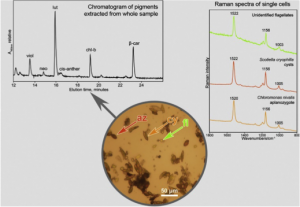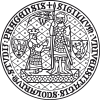 The potential of Raman microspectroscopy for the determination of carotenoid pigments (both primary: lutein, beta-carotene, and secondary: astaxanthin carotenoids) in the different species and life-cycle stages of snow algae from the order Chlamydomonadales (Chlorophyta) was tested alongside a comparison of a reference method of biological pigment analysis: high-performance liquid chromatography. The three main carotenoid Raman bands of the astaxanthin-rich red cysts were located at 1520, 1156 and 1006 cm−1. The shifts (orange aplanozygotes and green motile cells with flagella) in the position of the ν1(C=C) Raman band of the polyenic chain is consistent with the expected changes in the ratios of the various carotenoid pigments. Flagellated green cells commonly contain lutein as a major carotenoid, together with minor amounts of β carotene and varying amounts of antheraxanthin, violaxanthin and neoxanthin. Aplanozygotes contain mixtures of both primary and secondary carotenoids. In most cases, the ν1(C=C) band is an overlapping set of bands, which is due to the signal of all carotenoid pigments in the sample, and a deconvolution along with the band position shifts (mainly ν1) could be used to characterize the mixture of carotenoids.
The potential of Raman microspectroscopy for the determination of carotenoid pigments (both primary: lutein, beta-carotene, and secondary: astaxanthin carotenoids) in the different species and life-cycle stages of snow algae from the order Chlamydomonadales (Chlorophyta) was tested alongside a comparison of a reference method of biological pigment analysis: high-performance liquid chromatography. The three main carotenoid Raman bands of the astaxanthin-rich red cysts were located at 1520, 1156 and 1006 cm−1. The shifts (orange aplanozygotes and green motile cells with flagella) in the position of the ν1(C=C) Raman band of the polyenic chain is consistent with the expected changes in the ratios of the various carotenoid pigments. Flagellated green cells commonly contain lutein as a major carotenoid, together with minor amounts of β carotene and varying amounts of antheraxanthin, violaxanthin and neoxanthin. Aplanozygotes contain mixtures of both primary and secondary carotenoids. In most cases, the ν1(C=C) band is an overlapping set of bands, which is due to the signal of all carotenoid pigments in the sample, and a deconvolution along with the band position shifts (mainly ν1) could be used to characterize the mixture of carotenoids.
Osterrothová K., Culka A., Němečková K., Kaftan D., Nedbalová L., Procházková L., Jehlička J. (2019): Analyzing carotenoids of snow algae by Raman microspectroscopy and high-performance liquid chromatography. Spectrochimica Acta A 212, 262-271. (DOI)








